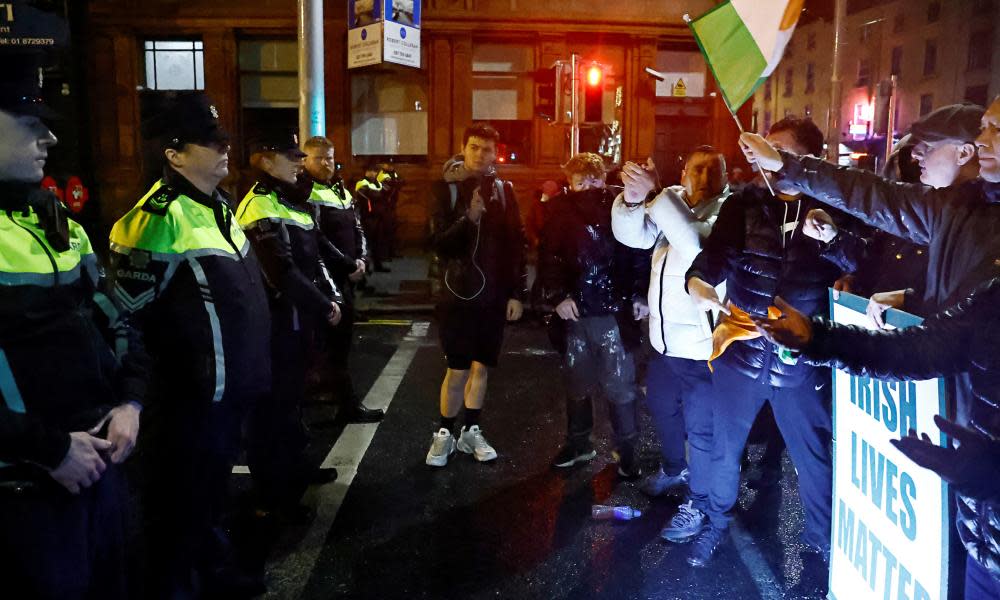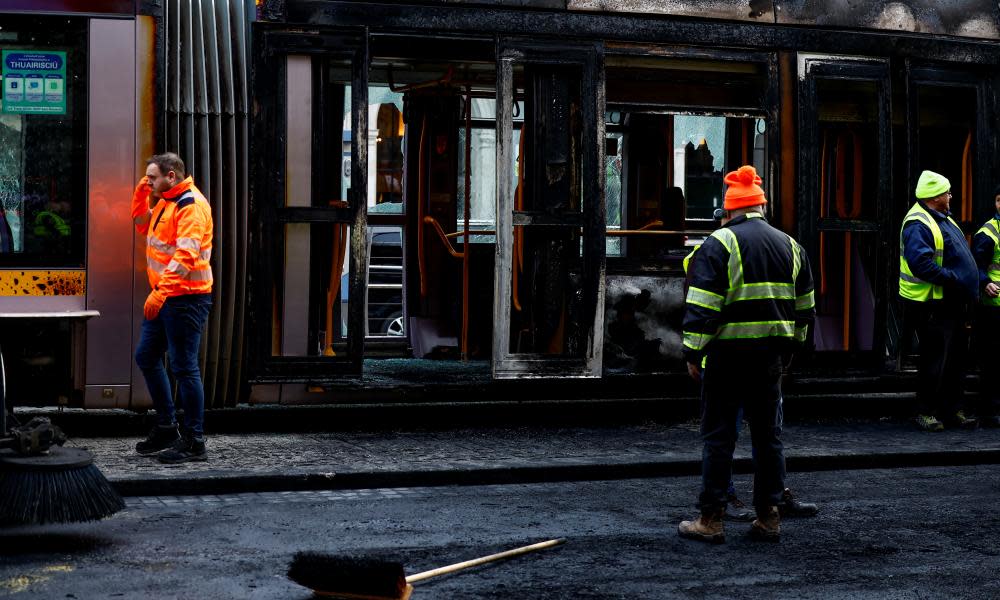‘Government is not listening’: anger over immigration spills into riot on Dublin’s streets

The young rioter surveyed the scene. A bus and a car blazed on O’Connell Bridge while masked groups marauded across the city centre looting shops, attacking police and shooting fireworks, turning the air acrid.
A police helicopter hovered and officers with shields and batons were assembling at the far end of O’Connell Street but the heart of Dublin, for now, belonged to the young man in a black hoodie who started to dance in the glow of the flames.
Comrades cheered as he punched the air and jigged to a soundtrack of breaking glass, shouts and sirens. He held his arms aloft like Rocky and paused, mesmerised by the mayhem. “Beautiful,” he said. “Fuck-ing beautiful.”
For other people in Ireland and elsewhere who saw images of Thursday’s anarchy it was the night Dublin went mad. For participants it was the night the city came to its senses – that here was an overdue venting of rage, a reckoning.
Ireland, according to this narrative, has opened the floodgates to foreigners with no controls or checks, leaving rapists and murderers to prowl the streets, and no one – not the government, not opposition parties, not the media, not the police – is taking it seriously.
So when social media rumours attributed a horrific stabbing attack on three children and a creche worker to a foreigner – Algerian, Moroccan, Romanian, versions varied – groups descended on Parnell Square, the scene of the crime, and decided to unleash chaos.
“People need to fight for this country,” said Samantha, a 27-year-old mother, as masked youths clashed with police attempting to retake Eden Quay along the River Liffey. “I’m not racist; I don’t mind people coming in if they respect Irish people. But the likes of the toerags coming into this country – they’re not vetted and are causing havoc.”

The unfolding scenes, in contrast, were legitimate havoc, a corrective to a political establishment impervious to previous protests over rising numbers of asylum seekers, said Samantha. “When we do things peacefully we get ignored.” She had left her five-year-old at home without dinner in order to join the revolt, she said. “I’m out here fighting for my country. We shouldn’t have to do this.”
Others echoed the refrain: to make Ireland safe, wreck the capital.
“It’s not right but it had to be done. The government is not listening,” said one man in his 20s, a bystander rather than a looter. “This isn’t against foreigners. We were the first emigrants. Immigrants are driving our buses, cleaning our hospitals – we need them. But they need to be vetted.”
Ireland’s demography has been transformed in recent decades as a booming economy reversed the historical flow of emigration. A fifth of the 5 million people now living in Ireland were born elsewhere. A recent increase in refugees from Ukraine and other countries fuelled a backlash amid concern over a housing shortage and straining public services. The number housed by the state jumped from 7,500 in 2021 to 73,000 in 2022.
Amid the destruction on Thursday night there was some linguistic nuance, with “non-national” usually preferred to “foreigner”, and “unvetted” or “unregulated” preferred to “illegal”, and an aversion to the label “far right”.
There was nothing subtle about the targeting of police. Bottles, bricks, fireworks and other missiles rained down on officers, many of whom lacked helmets and shields. The crowd cornered and attacked isolated officers, leaving several injured. Eleven police vehicles were damaged.
Journalists too were unwelcome and photographers had to conceal cameras. “He’s with the Guardian,” a man in his 60s, holding a tricolour, shouted. Younger, hooded men formed an intimidating cluster. The worst sin was to be with RTÉ, the national broadcaster, or the liberal Irish Times, which were accused of cheering the “replacement” of Irish people by new arrivals.
Many onlookers were appalled. “It’s heartbreaking for Dublin, for Ireland, for Europe,” said Matthew Butler, 28. A 53-year-old postman who gave his name only as John expressed fury. “Just a bunch of scumbags out to wreck Dublin city. The gardaí [police] should have free rein to beat the shit out of them.”
On Friday, Leo Varadkar, the taoiseach, said the rioters had shamed themselves and Ireland. “I want to say to a nation that is unsettled and afraid: this is not who we are – this is not who we want to be – and this is not who we will ever be.” The Garda commissioner, Drew Harris, blamed the disturbances on a “lunatic, hooligan faction driven by far-right ideology”.
The mob had diverse motives. Some belonged to fringe political groups and were veterans of protests against refugee centres. Some were opportunistic gangs that seized the chance to loot sportswear and alcohol. Others came for the spectacle and the chance to post dramatic footage on social media.
All, however, scorned the idea that Ireland is a safe, stable society. The economy is at full employment and the state is flush with tax revenue but their social media feeds depict a country overrun with “non-native” predators such as Jozef Puska, a Slovak man convicted earlier this month of murdering a teacher, Ashling Murphy, in 2022. As the night wore on, an unfounded rumour spread that one of the children in the Parnell Square attack had died.
It did not seem to matter that one of the people who stopped that attack was a Brazilian Deliveroo rider, Caio Benicio, and that Dublin gangs have assaulted numerous South American couriers in recent years.
Chilling threats of assaults against immigrants were made on a WhatsApp group titled “enough is enough”. “Everyone bally [balaclava] up, tool up,” said one man. “Let’s show the fucking media that we’re not a fucking pushover, that no more fucking foreigners are allowed into this poxy country.”
However, the mob targeted property and police rather than foreign and non-white bystanders, who watched in bewilderment.
As police gradually regained control James, a 33-year-old labourer, confronted a phalanx of shields on Burgh Quay, drawing cheers from others who hurled missiles. After being sprayed in the face, James staggered back to Butt Bridge where a Brazilian man, who had experience of being teargassed in his home country, offered recovery tips.
James thanked him but in an interview said “unregulated” arrivals were ruining Ireland. “We’re rammed to the gills with foreigners doing mad shit. You can’t do this to Irish people. I’m getting out of this country, I’m burning rubber. It’s not safe to walk around here.”
Mohammed Gaber, 27, an accountant who moved to Ireland from Sudan and is now an Irish citizen, came into the city centre to check on his sister, Ebba. He lauded his adopted home but worried about what the riot might augur. “Irish people are so welcoming. I’ve never experienced any discrimination. But this is crazy. This is the first time that I feel that there is something big.”
With roads sealed off and smoke pluming over Dublin, Ebba, 33, was blunter. “This is terrifying.” She was not sure of reaching her job as an emergency doctor at a police station.


